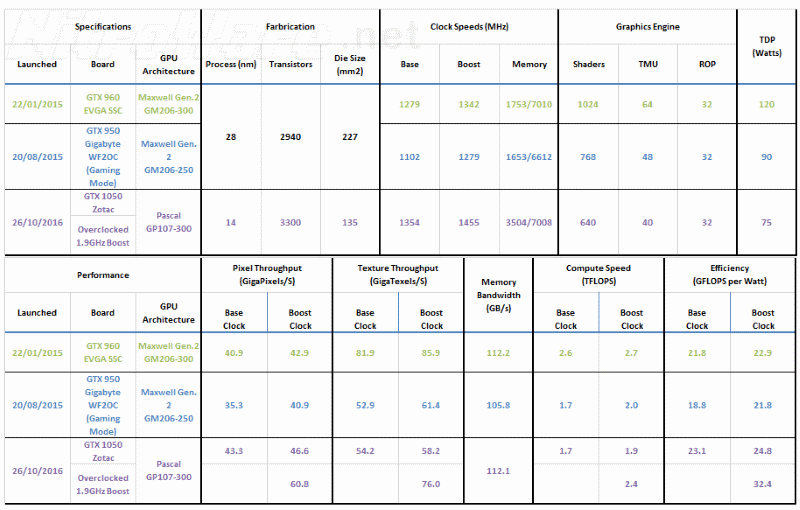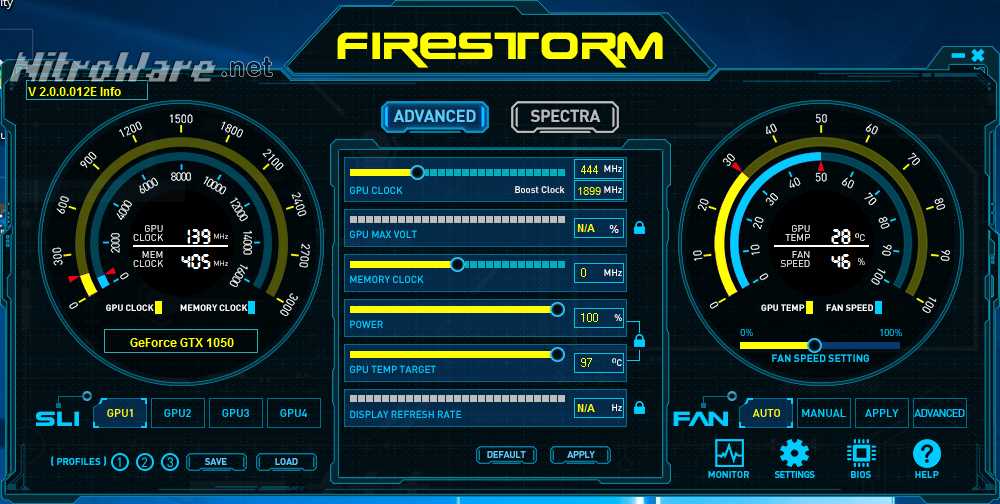GTX 1050 - Specifications and Overclocking
Comparing NVIDIA's GM206 and GP107 GPUs
Before we look at the real-world gaming performance and power consumption, we will compare the paper technical specifications of the Graphics Cards compared in this review
The way NVIDIA has been marketing 1050 to the media and consumers has been a bit convoluted.
They advertise the 1050/TI performance increases against the old 'Kepler' based GTX 650 as they also did for the GTX 950. The 1050 replaces the 750 Ti and 950 in the product stack and the press kit provided to media shows the 1050/Ti Benchmarked against the AMD Radeon RX 460, its direct competitor.
Confused? Sure. Let's ignore the now very old 650 and its comparison as NVIDIA advertises up to 50% uplift there, as they promised similar numbers for the GTX 950, which has similar paper specs in graphics throughput and compute horsepower.
What you need to know is GTX 1050 competes with AMD's Radeon RX 460 and GTX is faster and more powerful on paper. The 1050 Ti bordering on the GTX 960. After the 1050 announcement, AMD put out their own counter information to the media even acknowledging this despite still trying to push the virtues of Radeon technology.
This review is purely 1050 focused so the below table summarises the specification differences between purely GTX1050 and its predecessors, leaving the 1050 Ti out for now ( 768 cores, 48 TMU, 32 ROP. 1290 MHz base Clock, 1392 Boost Clock, 3504 Memory clock giving us 41 Giga Pixels per second and 61 Giga Texels/sec from 2.1 TFLOPS of compute horsepower). There is much not much point referencing a GPU whether its the 1050 Ti or Radeon RX if not tested here.

At 135mm2 GM107, the chip in 1050/Ti is 60% of the size of GM206 (GTX 950,960 and some examples of GTX 750 Ti) thanks to the smaller and lower power 14 nanometre FinFET process that Samsung's chip foundry business has used to build this GPU for NVIDIA.
GTX 1050 uses a 'binned' version of the GM107 chip, the fully enabled chip has 768 cores, 48 Texture Units and 32 ROPs. These Three figures are the basic building blocks of a modern GPU. Each handles a different part of the computation and rendering process to convert data into graphics on the screen, the more of these the faster and more powerful the GPU is.
Transistor count is up due to the additional features provided by Pascal generation GPUs, but overall power is down not just the Typical Board Power but operating voltage.
Not all of the improvements are due to the improved 16nm/14nm process used on the Pascal family, but each new generation of GeForce core has updated and improved logic designs that improve the throughput, efficiency and load balancing capabilities of the CUDA Cores, Rasterizers, Tessellation Units, Thread Schedulers, Memory controllers and other logical processing units that are essential parts of the 3D graphics pipeline.
The efficiency column is quite important, showing how much compute horsepower per watt of power the GPU is able to achieve.
Overclocking the GTX 1050
I tested both GPU Core (Boost Speed) as well as memory overclocking separately to determine which of these parts has more influence on performance.
To keep this review simple, the boost clock was 'only' overclocked to 1.9GHz (+444), not any other speeds using Zotac Firestorm utility which allows setting the Boost clock, and +200MHz on the GDDR5 memory (7.8GHz). During our briefing from NVIDIA on the new cards, they claimed they easily achieve 1.9 in their testing so that was the mark we wanted to verify.
The 128bit wide GDDR5 memory at 7GHz is not a bottleneck for the card in our tests or at least its specific number of CUDA cores. Bumping the memory gives us no tangle benefit. Our GTX 960 has the same memory interface therefore its all on the GPU engine to deliver any additional performance, noting that Pascal has improved memory and color compression to save memory space and bandwidth.
Not all benchmark points were re-tested at the overclock speeds to keep comparisons simple and easy to read.
The bus powered ZOTAC GTX 1050 only offers an adjustable temperature target. Power target is not an option due to the fixed bus power available. No voltage setting is avalible out of the box.
Our overclocking aims to answer two questions: Can the weaker GTX 1050 match or beat the GTX 950 or the GTX 960? We used synthetic benchmarks and games to aid in this quest.
The GTX 1050 is meant for the 'typical gaming' so its best to try actual games on it, although some enthusiasts do overclock their GPUs just for fun or sport.
